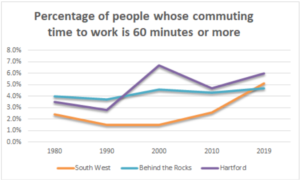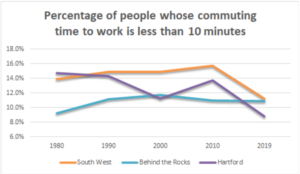Transportation
Transportation in Hartford was deeply impacted by the Federal-Aid Highway Act of 1956 which was passed under the administration of President Dwight Eisenhower. The law authorized the construction of a 41,000-mile network of interstate highways as a defense mechanism by making transportation more efficient in the country. In Hartford, the Federal-Aid Highway Act resulted in the construction of Interstate 84 and Interstate 91. These highways had tremendous consequences on the city’s fabric because I-84 isolated the North End from downtown and consumed a large swath of land with many historic buildings, and I-91 cut off Hartford from the Connecticut River.
For this project, we compared the commuting times to work in South West and Behind Rocks neighborhoods with the city of Hartford to see how they have changed over time (See Graphs 1 & 2). There has been a subtle increase in the percentage of people who commute more than 60 minutes to work and a decrease in the percentage of people who commute less than 10 minutes to their work. This shows an overall increase of time spent commuting to work caused by traffic and the distance required to get to work. Similarly, we also compiled how the type of transportation used in South West and Behind the Rocks has changed since 1980 (See Graph 3/PowerPoint for Story Mode). The main method of transportation continues to be personal vehicles (car, van, trucks, etc.), but we saw an increase in the number of people working from home in 2019 due to the Covid 19 Pandemic. The trends observed in South West and Behind the rocks match the trends observed in Hartford.
To view map for means of transportation https://www.socialexplorer.com/af404f3920/view

